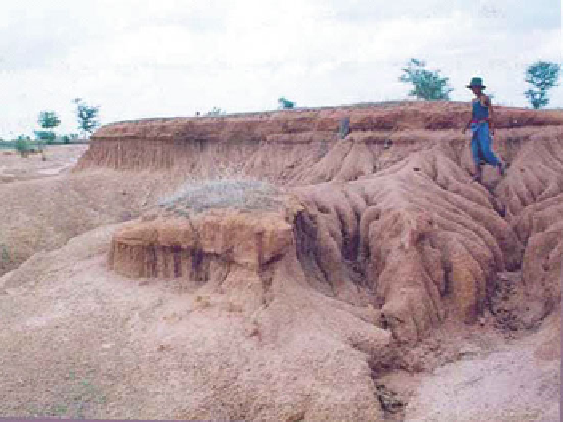Geoscience Reference
In-Depth Information
Fig. 14.2
Severe gullying and soil loss can follow deforestation and inappropriate cultivation
methods
and the destruction of habitat for native flora and fauna. Like the other forms of
watershed degradation already discussed, land degradation due to deforestation or
land clearing occurs as the direct consequence of poor or inappropriate land-use
practices and can be avoided through the application of sound land-use planning
and management principles. Good management implies sound overall ecosystem
management, a process which requires the striking of a balance between economic
objectives for productive land use and ecological objectives for the maintenance
of ecosystem quality and diversity. Putting it another way, this kind of approach
requires the adoption of an ethic of ecologically sustainable development, which in
itself is the essence of the integrated watershed management approach.
Further downslope, as rates and volumes of run-off and quantities of transported
sediment increase, larger-scale erosion processes begin to occur (Fig.
14.2
).
Gully erosion is essentially a macro-scale version of rill erosion which results in
the form of large, incised erosion channels too big to be filled by normal cultivation
practices and too wide and deep to be crossed by farm machinery. The classification
of gully erosion is usually applied when the depth of the incised channels exceeds
300 mm, although depths of 10 m and more may be experienced under severe
erosion conditions (Figs.
14.2
,
14.3
,and
14.4
). Gully erosion involves a number of
interacting processes which depend upon climate, soil type, topography and land
use. It is initiated in minor drainage lines when normal equilibrium is upset by
concentration of water flow or locally decreased resistance of soil to detachment
or transport. It develops by two major mechanisms - gully head erosion, which
is caused primarily by concentrated flow over the gully head and is the process
by which the gully lengthens and moves upslope, and gully side erosion, which
can be caused by diffuse over-edge inflow, interflow and groundwater seepage,

Search WWH ::

Custom Search